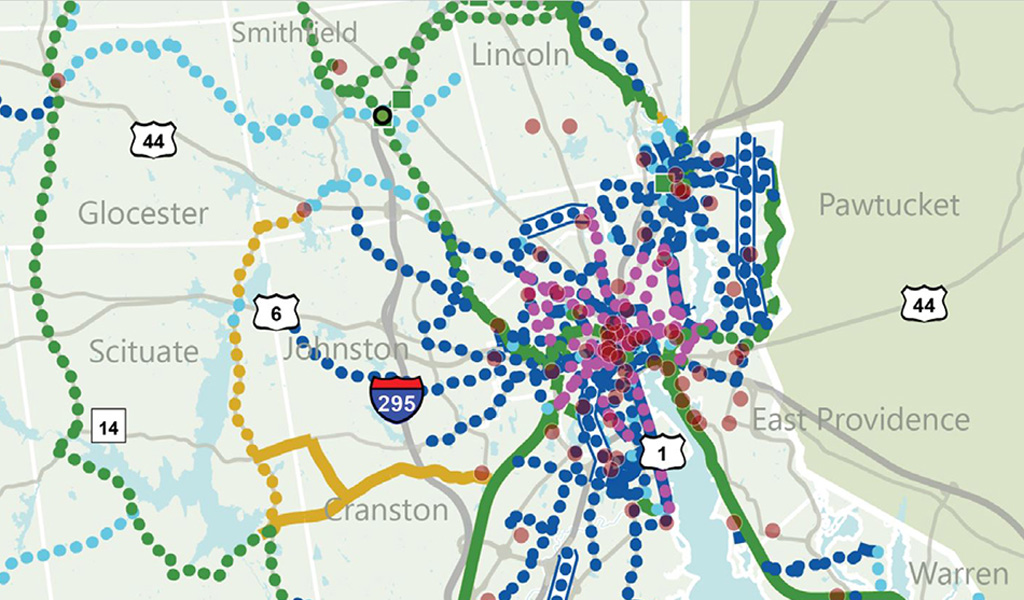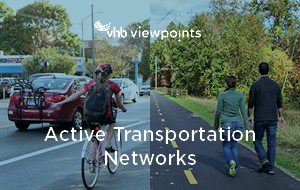When Joe Wanat discusses mobility and active transportation, he puts extra emphasis on transportation being more equitable and accessible for all. Equity is an essential component to the work VHB does in transportation. We asked Joe, to tell us more about the statewide Rhode Island Bicycle Mobility Plan and discuss how equity factored into the plan to elevate active transportation options for communities.

VHB: You partnered with the Rhode Island Division of Statewide Planning on the development of a statewide bicycle mobility plan. Can you tell us more about the project?
Joe: The overarching goal in developing the bicycle mobility plan was to take an in-depth look at cycling in the Ocean State—identifying gaps in the network, underserved destinations, and neighborhoods and then strategizing on how best to implement the necessary plans, programs, and policies.
Our starting point was to outline a 20-year vision and then build out the framework for Rhode Island’s bicycle mobility plan, while taking into consideration the uniqueness of each municipality, leaving flexibility for them to tailor the plan to match their specific community needs.
VHB: What was VHB’s role in the plan?
Joe: As the prime consultant partnering with the Rhode Island Division of Statewide Planning, VHB was the primary author of the mobility plan, working closely with our teaming partners Alta Planning & Design, Pare Corporation, and Cogent. A large part of the development of the plan was to determine which key travel corridors needed prioritization for better bike infrastructure to accommodate all ability types and trip purposes.
The project was underpinned by a robust public engagement program. Early in the planning process, we formed an advisory committee and invited members of bike advocacy groups to participate. Their insight and vast knowledge helped us orchestrate outreach to the communities using activity-based workshops and interactive online feedback maps, as well as low tech mapping exercises to increase engagement, consensus, and overall visibility of the plan.
VHB: We are hearing more about equity and accessibility in transportation? Why is this so important?
Joe: That’s a good question. We found the underserved communities had the least amount of access to active transportation and are often the groups who need it most. While bicycle mobility is known for recreational use, it is also a significant transportation mode for urban commute trips. There is a vulnerable and notably underserved population who do not have a car to adequately access jobs, schools, grocery stores, and healthcare. The mobility plan considered equity as an evaluation criterion to prioritize bike infrastructure to traditionally underserved communities. Specifically, the plan created a statewide “equity index” that included factors such as age, limited English proficiency, low motor vehicle ownership, education levels, and low household income. Projects scored higher on the equity index and were therefore ranked higher in the statewide prioritization if they improved connectivity to these underserved areas.
VHB: What challenges did your team face with this project?
Joe: The greatest challenge was balancing the desires of the bike advocates with the realities of what can be done. Another challenge was having the public engagement reach across the state and be fair and equitable for those who did not have access or were not able to attend public events, and still have their voices heard. We had to be resourceful in our outreach, providing a fair representation of all voices. We offered a high-tech option for those with internet access to go online and share thoughts on locations and paths, and a low-tech option for those without internet access in the form of pop-up interventions at community events.
VHB: Tell us more about how your team increased public awareness and sparked community engagement.
Joe: One of the more strategic decisions at the outset of the project was selecting the advisory committee and including several bike advocates. They brought passion and a unique perspective to the community engagement piece due to their already established connections with cyclists in the State.
We targeted all urban, rural, and suburban communities using user-friendly graphics that clearly defined the plan for those familiar with bike infrastructure, and those wanting to learn more about the available options to make bicycling safe and attractive to users of all ages. The graphics were easy to read and follow, allowing all populations to see that regardless of age, need, or where you live, there was something for you in the plan.
VHB: What benefits to the community does a mobility plan offer?
Joe: A statewide plan must have balance. The Rhode Island Bicycle Mobility Plan allowed each city or town the flexibility to prioritize and modify the recommendations in a way that best addressed their specific needs. Many communities are looking for active transportation alternatives. This plan connected the State – allowing residents to have a healthy alternative to driving. Like puzzle pieces, each municipal plan needs to fit with the adjacent municipality so that on a statewide level there is a cohesive, continuous, and connected network.
VHB: What were some lessons learned or best practices to pass along?
Joe: The process is far more important than the product, and the process is supported through effective and inclusive outreach. It’s important to use clear communication and images that represent the plan to increase community buy-in, engagement, and participation. The plan was embraced because it established a broad vision supported by discrete, implementable steps to achieve the vision. The plan was data driven with evaluation criteria for project prioritization that included unique factors such as equity, health, community support, and readiness in addition to the typical criteria of safety, utility, economic development, and density. It was important to take the approach that the plan cannot solve everything at once, that there are constraints, and that concessions may be needed to achieve the long-term vision.
VHB: Thank you for sharing Rhode Island’s award-winning Bike Mobility Plan. We hope to see more projects that increase mobility and provide more accessibility to active transportation.
Joe: I could not agree more. We were very pleased the project won a 2021 Smart Growth Award from GrowSmartRI. It is common to think of mobility and transportation in terms of bridges, rail, transit, highways, and arterials road networks. Healthy transportation options such as bicycling really serve to link communities at a more granular and local scale and connect underserved populations with access to jobs and housing and provide that last mile connection to other regional transportation options.
To learn more about VHB or this project, contact Joe Wanat.


